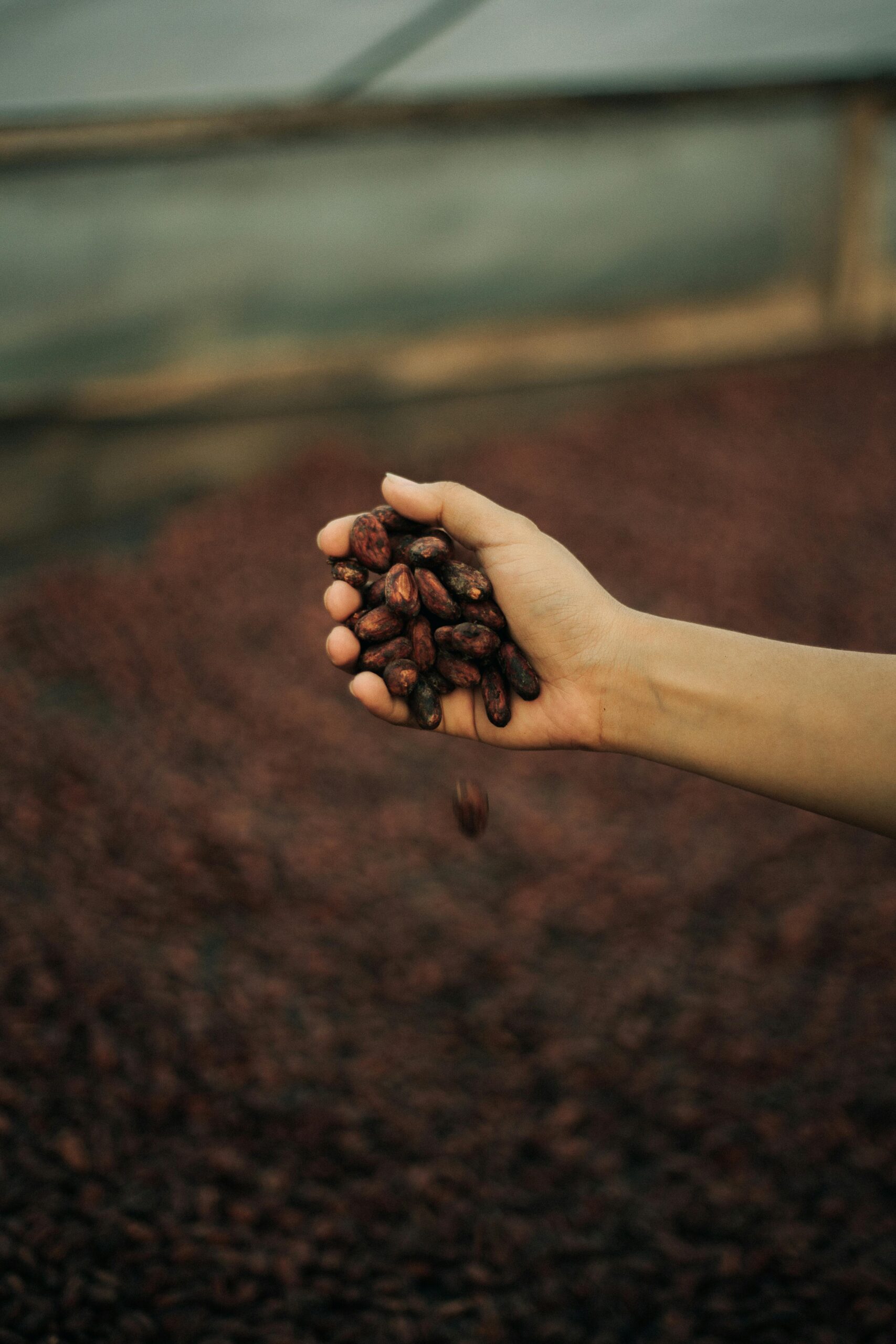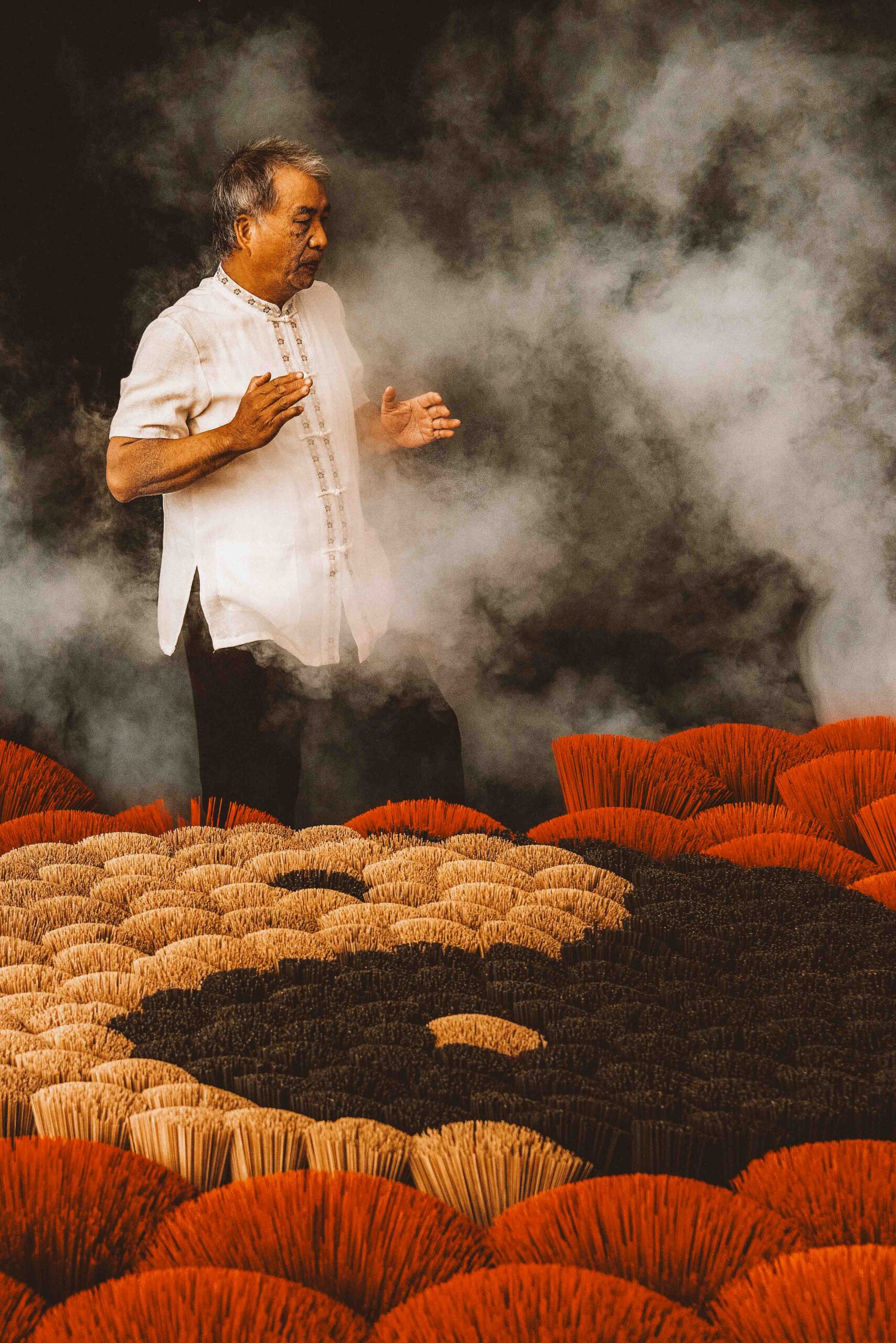My first experience with Cacao was when my then-boyfriend brought a couple of blocks of ceremonial cacao home after going to a Cacao Ceremony in Berlin. While I had heard of the healing properties and superfood wellness benefits of cacao I had never tried it before.
He was raving about how it really helps you get out of your head and into your body— I was eager to try it. We decided to set up a Cacao Ceremony at home and since that day Cacao has been a ritual in my life.
There are many ways how to have a Cacao Ceremony at home, and it doesn’t have to be a big fancy ordeal— or even with other people. You can have a low-key solo ceremony, or invite some friends to join you. It all depends on what you’re looking to get out of your cacao experience.
What is a Cacao Ceremony?
For those of you who are thinking, ok hold on a second, what is a Cacao Ceremony? Don’t worry— I was wondering the same thing when I first heard about it.
In the most basic form, a Cacao Ceremony is a ritual of sipping a hot ceremonial grade cacao drink.
Cacao Ceremonies date back to 1900BC. They are an ancient wellness ritual that was popular in Mayan and Ancient Aztec civilizations often conducted by Shamans for transitional ceremonies or before travels.
Today we’re seeing a resurgence of cacao ceremonies popping up globally as we rewild and reconnect to the ancient ideals around wellness. While the ceremonies aren’t exactly the same as the ancient ones, their essence is the same.
The goal is to open our hearts and deepen our connection with ourselves or the community that we are with, releasing any inhibitions, blockages, or self-doubts that are holding us back.
Unlock the Ancient Magic of Cacao at Home
Discover the Power of Cacao with Our All-Inclusive Ritual Guide and Audio Meditations.
What is Ceremonial Cacao?
The most important thing about a cacao ceremony is the grade of the cacao. It’s not your average cacao that you find in your supermarket— or even the chocolate bars that are 100% dark chocolate. That’s usually cocoa, which is very different.
Raw Ceremonial Cacao is in its purest form. This means that it has not been defatted, and is processed as little as possible using low temperatures and cold pressed to ensure that it keeps its health benefits— which are vast.
“Normal” Cocoa, the kind you find in powder form in the supermarket has been processed at high temperatures and which lessens the potency of its key superfood ingredients like tryptophan (one of the happy chemicals), magnesium, and antioxidants.
When you’re preparing your at-home cacao ceremony making sure you get high-quality ceremonial cacao is extremely important.
Why Do a Cacao Ceremony?
If you’re new to the world of cacao ceremonies you might be wondering why you should do a ceremony in the first place.
There are many reasons to do a cacao ceremony including both wellness benefits and more spiritual-based benefits.
The unique makeup of cacao relaxes our muscles thanks to its high level of magnesium and increases our blood flow because of the Theobromine, we feel relaxed yet alert when we consume cacao.
This gives us a unique opportunity to be genuinely present— something that can be quite difficult for people with busy minds. Cacao allows us to easily connect with ourselves and the people around us.
How to Setup a Cacao Ceremony at home?
Let’s get into the good stuff about how to have a cacao ceremony at home.
Just like there are many reasons to do a cacao ceremony— there are many ways to have a cacao ceremony. Most of the time they also incorporate other rituals that invoke the senses such as smoke or sound baths. They can have guided meditations, breath work or song, and dance.
The basic steps of a cacao ceremony are:
Preparing the Cacao (See Cacao Recipe Below)
Give Thanks / Drink the Cacao
Pick Any Additional Activities Based on Your Intentions
The key to deciding how to set up your cacao ceremony is first deciding what you’re trying to get out of it, i.e. what is your intention? Are you trying to connect with yourself or connect to others?
If you’re doing a solo ceremony, are you doing it to cultivate self-love, or are you looking to bring openness and awareness to something in your life?
If you’re doing it with others, what’s the goal? The connection between the participants or general connection to the greater universal community?
After you have that figured out, you’ll have a better idea of the activities you should be doing during the ceremony.
There are no right or wrong things to do in the ceremony but here are some of the activities you can do:
Guided Meditation
Breath work
Singing & Dance
Journaling
Sound Bath
Smoke Rituals
Yoga
Pick the activities that speak to you and fit with your intention. For example, if I decide to do a ceremony by myself I tend to meditate, journal, and do yoga rather than singing and dancing since those feel better to connect with others.
Cacao Ceremony Recipe
Preparing the Cacao is quite simple and the recipe for the cacao drink can be altered to fit your taste. The key thing is making sure you have the right cacao (ceremonial grade) and that you’re using good cacao to liquid ratio. Somewhere around 42g of cacao mixed with 250 ml of liquid is ideal.
The liquid can be plant-based milk or water— whatever you prefer. You’ll melt the cacao paste in the liquid by warming it up on the stovetop until the cacao is fully melted.
In its natural state, it will be extremely bitter so you’ll want to add a little honey or agave to sweeten it a bit— try not to use any processed sugars to keep the wellness integrity of the drink.
You can also add spices like nutmeg, cinnamon, chili, or cumin to your cacao to give it a little more flavor— as long as they are natural spices or herbs, it’s all fair game and depends on your taste.
Once everything is completely dissolved into the hot cacao, it’s ready to be served while it’s still fresh and hot, starting the drinking portion of the ceremony.
What to expect from a Cacao Ceremony?
A lot of first-timers wonder what they can expect from a cacao ceremony. It’s normal to be curious about how cacao will make you feel— but it’s important to note that it’s not a psychedelic so the experience isn’t anything like that.
What you can expect is to feel energized and alert— yet extremely relaxed. This is a weird sensation since most stimulants that energize us also make us jittery which isn’t relaxing. This is what makes cacao so unique. However, I will say that although it is quite energizing, sometimes when I am doing a solo ceremony it’s normal that I feel the need to lay down and sometimes doze off because I am in such a relaxed state— especially after meditation.
How to incorporate cacao into your daily life
It’s important to note that cacao doesn’t have to be consumed only in a ceremonial setting. I have incorporated a morning cacao ritual into my life on a weekly basis. It’s a great way to reap the wellness benefits of cacao, without having to go through a whole ceremony each week.
However you decide to use cacao in your life, I hope that you’ll be presently surprised by the richness not just of the chocolatey taste, but also of the ability to connect with yourself and the world around you.
Good to Knows & FAQs About Cacao
When we talk about cacao ceremonies or ritual cacao, we’re not talking about chocolate.
We’re talking about ceremonial grade raw cacao.
This cacao is specifically grown, harvested, and prepared with the intention of being used in traditional ceremonies and rituals.
Purity and Quality: Ceremonial grade cacao is made from heirloom cacao varieties, typically grown in specific regions, often in Central and South America.
The beans are minimally processed, usually stone-ground, and cold pressed. It is always free from additives such as sugar, dairy, or artificial flavorings.
Energetic and Spiritual Connection: This cacao is considered sacred and is often used in spiritual practices for its ability to open the heart, enhance meditation, and create a sense of connection with oneself and others.
The process of preparing and consuming the cacao is done with mindfulness and intention, often as part of a ceremonial gathering.
Sourcing and Sustainability: Ceremonial grade cacao is typically sourced from small, family-owned farms that follow traditional farming practices.
The production often supports indigenous communities and helps to preserve the cultural heritage associated with cacao cultivation.
Want to learn more? Read our article about the difference between cacao and cocoa.
Every cacao ceremony or cacao ritual looks a little different, but there’s always the undertone of connecting with yourself, the others there and opening your heart.
This cacao ritual is set up in the following way:
- Preparing the Cacao Mindfully
- Opening the circle with intention
- The Mindful First Sip Ritual
- Guided Meditation & Sound Bath
- Sharing and Closing the circle
A cacao ceremony offers profound effects on both the energetic and spiritual levels. The ceremonial grade cacao, revered as sacred, acts as a powerful heart opener, gently facilitating emotional release and deepening our connection to the present moment.
When consumed in a mindful, intentional setting, this cacao enhances meditation, allowing participants to access heightened states of awareness and inner clarity.
The ceremony itself becomes a space for spiritual exploration and healing, where the shared experience of cacao creates a sense of unity and connection with others.
As the cacao works to open the heart, it invites us to connect more authentically with our emotions and with those around us. This energetic shift often leads to a profound sense of love, compassion, and interconnectedness.
The history of cacao ceremonies dates back thousands of years to ancient Mesoamerican civilizations, particularly the Mayans and the Aztecs, who revered cacao as a sacred plant.
Cacao was considered a divine gift from the gods, often associated with fertility, abundance, and the spirit of the earth. The Mayans referred to it as “the food of the gods,” and they integrated cacao into their religious practices, using it in rituals to connect with the divine and to offer blessings to their deities.
The Aztecs, too, held cacao in high esteem, using it in ceremonies to honor their gods, as well as in rites of passage, marriages, and other significant life events. For these cultures, cacao was not merely a food or drink but a powerful spiritual tool that bridged the human and the divine realms.
Unlike its ancient usage, which was deeply tied to specific cultural and religious practices, modern cacao ceremonies are often more eclectic and adaptable, blending traditional elements with contemporary spiritual practices.
These ceremonies are typically centered around the mindful preparation and consumption of ceremonial grade cacao, creating a sacred space for participants to connect with themselves and each other on a deeper level.
The emphasis is on using cacao as a heart-opening tool to facilitate emotional healing, introspection, and connection, often accompanied by meditation, breathwork, chanting, or other mindfulness practices.
In today’s cacao ceremonies, there is also a strong focus on the communal aspect, with participants coming together in a circle to share their intentions, experiences, and energies.
The setting can vary widely—from intimate home gatherings to larger events in wellness centers or nature retreats—but the core intention remains the same: to create a space of love, openness, and spiritual connection. This modern approach often emphasizes inclusivity, making the ceremonies accessible to people from diverse backgrounds and spiritual beliefs.
Additionally, there is a growing awareness of the importance of honoring the origins of cacao and the indigenous cultures that have traditionally used it, leading many facilitators to incorporate elements of cultural respect and education into their rituals.
Location:
- Place the altar in the center of the circle where participants will gather.
Foundation:
- Choose a cloth or mat as the base for your altar.
- Use something with spiritual significance or a design that resonates with the ceremony’s energy.
Natural Elements:
- Earth: Include crystals, stones, or plants.
- Air: Add feathers, incense, or an item representing the wind.
- Fire: Place candles or a small fire-safe item.
- Water: Incorporate a bowl of water, seashells, or flowers.
Cacao:
- Place the prepared cacao or raw cacao beans at the center of the altar.
Four Directions (optional):
- Include symbols for north, south, east, and west to honor balance and harmony.
Personal Items:
- Add items of personal spiritual significance, such as a talisman, photo, or sacred text.
Mindful Arrangement:
- Arrange the altar with intention, focusing on the energy you want to bring into the ceremony.
You can have a cacao ceremony anytime, but doing it with intention for something specific could include:
Full Moon:
- A powerful time for releasing what no longer serves you.
- Use the ceremony to set intentions for letting go and embracing new opportunities. Along with your other full moon rituals.
- The heightened energy of the full moon enhances emotional clarity and connection.
New Moon:
- Perfect for setting new intentions and planting seeds for the future.
- Focus on manifestation, new beginnings, and personal growth.
- The new moon’s energy supports deep introspection and renewal.
Seasonal Changes:
- Mark the transition of seasons (e.g., equinoxes and solstices) with a ceremony.
- Honor the cycles of nature and reflect on your own growth and transformation.
- Use this time to align with the natural rhythms of the earth.
Personal Milestones:
- Celebrate birthdays, anniversaries, or significant life events.
- Use the ceremony to reflect on your journey and set intentions for the year ahead.
- Gather loved ones to share in your celebration and strengthen connections.
Times of Transition:
- Hold a ceremony during periods of change, such as moving to a new home, starting a new job, or ending a relationship.
- Use cacao to ground yourself, find clarity, and embrace the new chapter in your life.
Special Gatherings:
- Host a ceremony as part of a retreat, workshop, or community event.
- Use the shared experience to build connections and foster a sense of unity among participants.
- Create a safe space for collective healing and spiritual exploration.
While some health food stores may carry ceremonial-grade cacao, sourcing it from trusted online suppliers is recommended to ensure quality and authenticity. Two of my favorites are:
Both offer a generous discount for Maia readers, with the codes ‘MAIACONSCIOUSLIVING’ and ‘MAIA’ respectively.












2 Responses